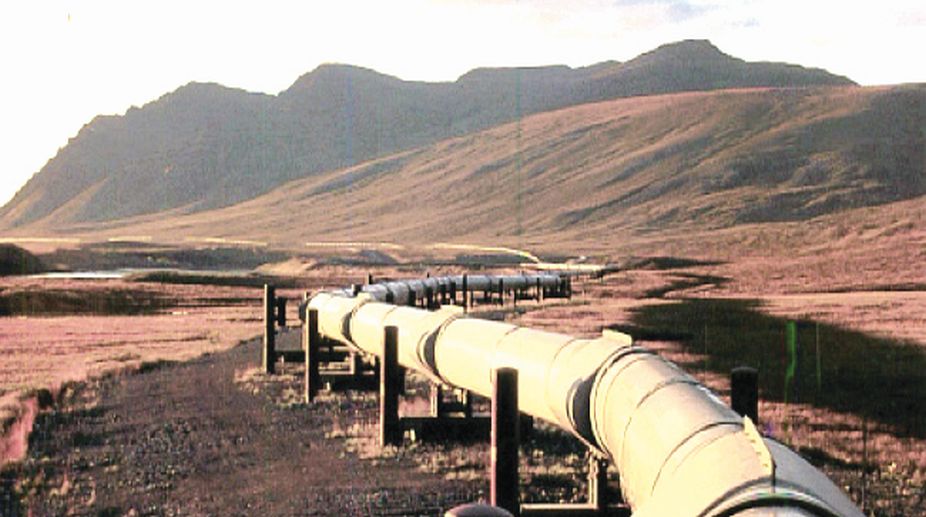A recent event that probably merited more attention than it received was the inauguration of a pipeline to bring natural gas from Central Asia to South Asia.
This is the ‘TAPI’ pipeline from Turkmenistan, where there are vast unexploited gas reserves, to South Asia where demand is constantly on the rise. TAPI bids fair to transform the region and convert what has been a rather neglected though resource-rich part of the world into a major growth area.
Advertisement
As it is, Turkmenistan has made a few distinctive forays into modern development, including through adopting white monumental buildings as its characteristic architectural signature, among which is a massive and striking Neutrality Monument which was commissioned and completed in the time of Turkmenistan’s founder-President Niyazov though it has had a chequered career since: still monumental in scale but trimmed down from its initial grandiose vision.
What the Neutrality Monument continues to display, notwithstanding the overstated grandeur of its design, is the country’s large ambition for its future while proclaiming the appearance of a newly significant national factor in regional affairs.
Oil and gas being such strategic and politically charged substances, it is only to be expected that TAPI will raise many useful development possibilities while also adding to the complexities of regional affairs.
The four countries that have combined under the title of TAPI (India, Turkmenistan, Afghanistan, Pakistan) have an obvious economic affinity that brings them together, much of it to do with their mutual interest in oil and natural gas. For India, historically the main source of hydrocarbons is the Gulf, especially Iran, though now Central Asia may become just as prominent.
At one level, the issues bringing the different countries of TAPI close together are obvious, given their mutual interest in production and export of natural gas and oil: for India the Gulf is the historic source of oil and gas, so that the region, including the major consumer India always keeps its eye on supplies from the Gulf even while diversifying supplies through imports from elsewhere. But the complexities are not far to seek, these being as much political as technical.
Moreover, in the last few years as natural gas from the Gulf and other nearby regions has become more readily available there has been a considerable opening in regional economic exchanges.
At the same time intra-regional political differences have also sharpened, as may be seen in the prolonged US attempt to restrict access to the global market for Iran. This US effort has an indirect bearing on TAPI; indeed, this pipeline can be seen as an alternative to another major similar project aimed at bringing Iranian oil and gas to South Asia, along a more direct route traversing Pakistan.
The USA has done what it could to block this particular route, known as the IPI alignment (Iran-Pakistan-India) which at one stage received support and backing from Tehran.
But problems arose when relations kept deteriorating and the USA and Iran moved into different orbits and both did what they could to block the other, and the IPI could not become the project that the protagonists sought to promote.
Over the years as major countries vied for advantage, pressures on IPI ensured that its wings should be substantially clipped and this Iran-centred project lose some of its advantages. As has already been mentioned the politics of oil and natural gas are complex and unpredictable.
At that time, in assessing its larger geo-political interest, India decided to keep participation in IPI in abeyance while concentrating on developing the
TAPI project: both offer benefits that are not easily transferred
to other partners, and both are very important in India’s future plans for economic development.
Relations between Iran and the USA have remained discordant and there is no current expectation of improvement. However, India and Iran have restored and enlarged their ties, to mutual benefit, as seen most strikingly in the development of Chabahar port on the Gulf which is set to become India’s point of entry to Central Asia and the fulcrum of economic interaction between South and Central Asia.
Far-reaching proposals for oil transportation are on the cards while projects from Turkmenistan and the Gulf, among others, will in all likelihood begin to take concrete shape before long, driven by unavoidable economic logic.
The formal ground breaking ceremony for the TAPI project that took place in Turkmenistan a few days ago has many facets that need to be kept in mind as this massive scheme takes shape. One of the biggest challenges so far as India is concerned is to participate in a structure that brings together in partnership with three others, one of which is Pakistan.
Though India and Pakistan share much in their economic development, at present there is a virtually unbridgeable gap between them owing to Pakistan’s persistent support for terrorism against India. This is the root cause of several failed prior attempts to break the impasse in their relations and try to move towards some sort of normality, and here is no present sign of change for the better.
If anything, the present time does not look like the best for a major initiative like TAPI for it brings India and Pakistan into unaccustomed proximity and establishes fresh regional ties that will need to be consolidated. All the more credit, therefore, to the Indian Minister who represented the country on the occasion, for his bold initiative in promoting the project.
The other leaders who were no less supportive and upbeat also saw this as a new page in cooperation between the four countries, while the President of Afghanistan, who was present, referred to the pessimistic early reactions when TAPI first came under consideration and pointed out that the initial doubts had now been resolved. He as well as the others had every reason to express their satisfaction for an agreement of this scale and potential merits the welcome it received.
Yet one should not ignore some of the challenges that TAPI will place before its participants. At present, it is envisaged that the bulk of the natural gas from the fields in Turkmenistan will be purchased by India and Pakistan; given the history of the differences between the two countries this may be no straightforward task but can be regarded as an important building-block
for regional peace and cooperation.
At present much of the natural gas from Turkmenistan is bought by China but that country’s dominant position in this regard is already coming under challenge, not least by the projected commissioning of TAPI. It is a time of change in Central Asia, and India as well as the others will have to remain alert as they explore new opportunities and challenges for the future.
The writer is India’s former Foreign Secretary.











